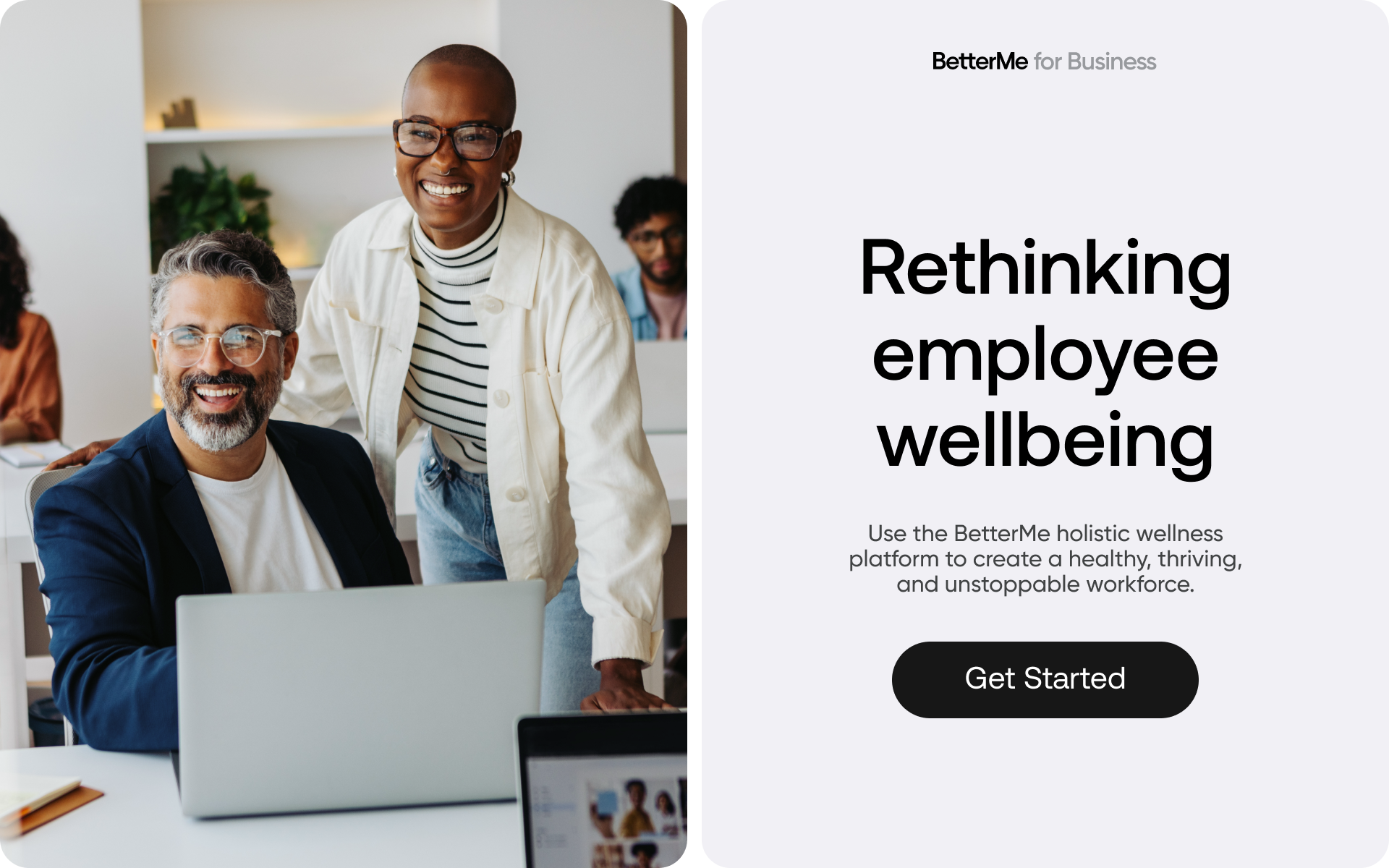Stress in the workplace has become a common challenge for businesses. High-pressure deadlines, heavy workloads, and workplace dynamics can leave employees feeling overwhelmed. While some level of stress is inevitable, unaddressed stress can lead to reduced productivity, absenteeism, and even burnout (1, 2). Fortunately, there are several proactive strategies for managing and mitigating stress in the workplace.
What Are Warning Signs of Stress in the Workplace?
Recognizing the early signs of stress is essential for intervention. These warning signs often manifest physically, emotionally, and behaviorally (3). Here are some examples you should look out for:
- Physical symptoms: Frequent headaches, fatigue, muscle tension, or gastrointestinal issues.
- Cognitive signs: Trouble concentrating, poor decision-making, and forgetfulness.
- Behavioral changes: Increased absenteeism, isolating from coworkers, or frequent irritability.
- Decreased performance: Missed deadlines and reduced enthusiasm for tasks.
- Health habits: Increased reliance on unhealthy coping mechanisms such as smoking, alcohol, or excessive caffeine.
When multiple signs appear consistently, this can be an indication that stress is impacting either individual employees or the entire team.
7 Tips for Stress Management in the Workplace
Proactively addressing stress benefits both employees and the business itself. Here are actionable steps for managing workplace stress effectively:
1. Encourage Physical Activity
Exercise is a proven way to lower stress levels (4). Even in a fast-paced work environment, short bursts of movement can have a significant impact.
Desk workouts are simple and effective. Encourage employees to try 5-10-minute exercises such as stretching, chair yoga, or quick brisk walks around the office. For example, BetterMe for Business offers actionable desk workout programs that teams can integrate into their daily routines.
Regular movement increases blood flow, releases endorphins (feel-good hormones) (5), and helps employees reset their focus and energy.
2. Promote Nutrition Awareness
What employees eat significantly impacts their energy levels and stress resilience. Providing access to healthy snacks will ensure better food choices throughout the day.
Here’s how to support better nutrition in the office:
- Stock communal areas with snacks such as nuts, fresh fruits, and yogurt instead of sugary treats
- Organize educational sessions with nutrition experts to highlight how balanced eating supports mental clarity and stress reduction
- Encourage hydration by making water readily available and accessible
Fueling the body with nutritious foods supports better mood and sustained productivity (6).
BetterMe has excellent tools for your business all in one place: a personalized approach to health and wellness, 1,500 workouts for every fitness level, a variety of meal plans and trackers to satisfy any dietary needs, mental health guides, and employer support. Discover all the options now!
3. Create Opportunities for Mindfulness
Mindfulness practices can calm stress responses and help employees stay present. Guided activities such as deep breathing, meditation, and body scans make mindfulness accessible, even during short breaks (7).
Businesses can incorporate mindfulness into their operations by:
- Hosting bi-weekly meditation sessions
- Providing mindfulness apps or using platforms such as BetterMe for Business for guided practices
- Creating quiet zones in the workplace for a stress-free environment to recharge
4. Prioritize Work-Life Balance
Work-life imbalance is a key factor that contributes to workplace stress and burnout (8). Encouraging balance among employees requires embedding flexibility and boundaries into the culture.
Consider introducing these practices:
- Allow flexible work hours wherever practical
- Set realistic expectations regarding after-hours communications and emails
- Encourage employees to take breaks, including vacations, for mental rejuvenation
Leading by example also ensures employees feel comfortable taking time for personal priorities.
5. Foster Social Connections
Healthy workplace relationships reduce stress and create a supportive environment. Peer connections enable employees to tackle challenges together rather than in isolation (9).
Practical ways to boost camaraderie include:
- Organizing team outings or virtual social events for remote teams
- Facilitating cross-departmental collaborations for enhanced interactions
- Launching peer mentorship programs to enable guidance and connection
A culture of mutual support can lead to higher morale across the board.
6. Provide Access to Stress Resources
Invest in tools and resources that are specifically designed to combat workplace stress. These could include:
- Employee assistance programs (EAPs) that offer counseling and mental health services
- Wellness apps with mental health courses, meditative practices, or burnout prevention programs
- Professional development workshops that build skills to manage workplace challenges
The availability of these resources demonstrates employer commitment to well-being.
7. Open Dialogue Around Stress
A stigma-free work culture encourages employees to share their stressors freely. Having open conversations prevents smaller issues from escalating into larger concerns.
Leadership can foster open dialogue by:
- Regularly checking in during team and one-on-one meetings
- Conducting anonymous surveys to understand stress points in the workplace
- Creating feedback mechanisms where employees feel heard and supported
Addressing concerns promptly often reduces prolonged stress.
Read more: How Corporate Wellness Nutrition Programs Can Improve Employee Health
What Are the Main Benefits of Stress Resilience at Work?
When employees combat stress effectively, both individuals and organizations experience notable benefits (10). These include:
Improved Productivity
Stress resilience directly impacts how employees handle their workloads. When employees can effectively manage stress, they stay focused and perform consistently, which leads to higher levels of productivity (11).
Stress often diminishes concentration and increases error rates (12). However, employees with strong coping mechanisms can better compartmentalize challenges and focus on their tasks.
For example, an employee who practices mindfulness or deep breathing may reset their mental state after a high-pressure meeting, which enables them to tackle their next project with fresh focus. Stress resilience allows team members to shift from a reactive to a proactive mindset, which is essential for efficiently achieving business goals.
Reduced Absenteeism
Chronic stress is a significant factor in employee absenteeism. Stress-related illnesses such as migraines, chronic fatigue, or anxiety often lead to employees taking time off from work (13). Stress resilience gives individuals the tools to manage these issues before they escalate into frequent sick days.
Organizations that invest in stress management programs, such as guided meditations or coping workshops, often report fewer absences. A leadership emphasis on stress resilience can also encourage open conversations about mental health, which can lead to early interventions and support before stress manifests physically (14).
Boosted Morale
A workplace that values stress resilience fosters a sense of empowerment and well-being among employees. When individuals feel equipped to manage challenges, their confidence grows, and they feel more engaged in their roles. Reduced stress levels also promote positivity, making collaboration and teamwork smoother.
For example, an organization implementing a wellness initiative such as group fitness challenges or gratitude exercises can see employees bond over shared goals. Improved morale enhances individual satisfaction and strengthens the collective workplace environment.
Cost Savings for the Company
Workplace stress drains financial resources. From healthcare costs to high turnover rates, the expenses tied to stress are substantial. Stress-resilient employees require fewer medical interventions, leading to decreased healthcare claims.
In addition, when employees handle stress effectively, they’re less likely to burn out and leave the organization. Lower turnover rates save companies the costs that are associated with recruiting, training, and onboarding new staff. Investing in wellness resources, such as those offered by BetterMe for Business, reduces long-term costs while improving employee health and satisfaction.
Enhanced Workplace Relationships
Stress often causes tension in workplace dynamics. Resilient employees handle conflicts constructively and maintain a balanced perspective in high-pressure situations. This ability fosters better relationships among team members, which strengthens collaboration.
For example, a team member who uses stress management techniques such as journaling or active listening may approach disagreements with empathy and a solution-focused attitude. This prevents stress-induced miscommunications from derailing projects or relationships, which improves overall workplace harmony.
Greater Creative Problem-Solving
High levels of stress inhibit creativity by triggering survival-based thinking. However, stress-resilient employees have the mental clarity to think innovatively. They approach challenges with a broader perspective, exploring creative solutions without being overwhelmed by pressure.
For example, a stress-resilient marketing team brainstorming amidst tight deadlines is more likely to generate fresh ideas than one that is bogged down by anxiety. Organizations that promote resilience see employees thrive, even under demanding circumstances, which improves both output quality and job satisfaction.
Sustained Employee Engagement
Stress resilience maintains high engagement levels by preventing emotional exhaustion. Employees who handle stress effectively maintain enthusiasm for their tasks and feel motivated to contribute. Resilience practices, such as prioritizing tasks and incorporating breaks, prevent work from feeling overwhelming, which fosters long-term engagement.
Organizations with wellness programs that emphasize mindfulness, movement, and balance often observe employees taking ownership of their work with more energy and commitment. This makes them feel more connected to both their roles and the company’s mission, which promotes sustained growth.
Stress resilience doesn’t just mitigate risks – it unlocks valuable gains and this translates into a healthier, high-performing, and thriving workforce.
What Role Does Leadership Play in Stress Resilience at Work?
- Modeling Wellness Practices
Leaders set the tone for how stress is perceived and managed in the workplace. When managers prioritize their own wellness, they are signaling to employees that it’s both acceptable and essential to do the same – for example, a manager who openly takes short breaks for mindfulness or exercise normalizes such practices for their team.
Furthermore, leaders who set boundaries, such as avoiding after-hours emails, demonstrate the importance of a work-life balance. This behavior encourages employees to respect their own downtime, which reduces the long-term risk of burnout. Modeling wellness isn’t about perfection, it’s about leading by example and showing employees that managing stress is an ongoing process.
- Implementing Leader-Driven Wellness Initiatives
Leaders play a pivotal role in introducing and championing wellness programs in the organization. These initiatives go beyond providing resources – they ensure employees see and feel the benefits of stress resilience efforts. For example, a leader may organize weekly team mindfulness sessions or encourage participation in short desk workout programs through platforms such as BetterMe for Business.
Leaders can also take an active role in recognizing stress among their team members. This could involve hosting wellness check-ins during meetings, where employees are reminded to take breaks or adopt coping techniques. Such leader-driven initiatives promote stress management and foster a culture of care and support in the organization.
- Continuously Assessing Workplace Policies
Leadership doesn’t stop at promoting wellness on the surface. To truly support stress resilience, managers must regularly evaluate and adjust workplace policies to ensure a supportive environment.
For example, unrealistic deadlines, excessive workloads, or a lack of resources can be significant sources of stress. Leaders who actively address these issues help prevent stress from becoming a systemic problem.
Consider a leader who reviews team workloads quarterly, reallocating tasks where necessary to avoid employee burnout. Similarly, leaders can assess the effectiveness of existing wellness programs by gathering feedback from employees. Providing flexibility, such as hybrid work options, is another way to ensure policies work for everyone.
Leadership shapes how stress is managed and mitigated in the workplace. By modeling wellness, championing initiatives, and refining policies, leaders can create a resilient and balanced work environment. This ultimately promotes employee well-being and aligns with the organization’s goals of productivity and growth.
Are you looking to transform both your business and the lives of your team members? BetterMe corporate wellness solutions provide a holistic approach to physical and mental health that boosts productivity and job satisfaction.
How Can Workplace Culture Support Stress Resilience?
A workplace’s culture is the backbone of stress resiliency. A wellness-focused culture values mental and physical well-being equally with performance.
Embedding wellness into culture involves:
- Offering flexible wellness programs that are tailored to employee needs.
- Recognizing and celebrating healthy habits such as fitness accomplishments or reduced stress levels.
- Balancing workloads to prevent unnecessary stress from unrealistic demands.
- Providing resources such as access to mental health professionals or financial wellness programs.
- Promoting open communication and a safe space where employees can express their needs and concerns.
- Encouraging work-life balance by respecting personal time and boundaries.
A workplace that prioritizes wellness creates an environment that nurtures stress resilience. It promotes healthy habits and behaviors while acknowledging the importance of overall employee well-being. This then leads to a more positive work culture where employees feel supported and motivated to tackle challenges with confidence.
Read more: Wellness Tips For Employees: Leadership And Well-Being
What Are the Best Stress Management Techniques for Employees?
Employees can integrate the following techniques into their daily routines to manage their stress effectively:
- Time management: Prioritize tasks and break large projects into manageable segments.
- Mind-body interventions: Practices such as yoga, tai chi, or progressive muscle relaxation ease mental and physical stress.
- Journaling: Reflecting on daily stressors helps employees gain clarity and find solutions.
- Gratitude practice: Recognizing positives promotes an optimistic mindset, which offsets stress.
- Skill-building for stress coping: Short workshops on resilience or communication tactics build confidence and control.
Empowering employees with practical tools ensures that stress management becomes a consistent practice rather than a temporary solution.
Common causes of stress at work include excessive workloads, unrealistic deadlines, lack of support from managers or colleagues, unclear job expectations, and conflicts in the workplace. Other contributors can include job insecurity, lack of control over your work, and insufficient recognition for achievements (15). Employees can support each other by fostering open communication, offering empathy, and collaborating on shared challenges. Encouraging teamwork and peer mentorship can help alleviate stress by creating a sense of community. Sharing stress management techniques such as mindfulness or organizing short breaks together also builds collective resilience. A healthy work-life balance is essential for stress resilience as it allows employees to recharge and focus on personal priorities outside of work (16). When employees maintain boundaries between work and personal time, they’re less likely to feel overwhelmed and will be better equipped to handle workplace stressors. Flexible schedules and taking breaks can greatly enhance this balance. Yes, stress resilience can improve employee productivity. Employees who manage stress effectively maintain focus, think clearly, and make better decisions, which leads to higher efficiency. With fewer distractions caused by stress, workloads can be handled more proficiently, and quality of work increases.Frequently Asked Questions
What are common causes of stress at work?
How can employees support each other in building stress resilience?
How does work-life balance affect stress resilience?
Can stress resilience improve employee productivity?
The Bottom Line
Stress in the workplace doesn’t have to disrupt productivity or morale. By recognizing warning signs early, implementing stress management practices, and fostering a wellness-oriented culture, businesses can help employees thrive.
Leadership and organizational commitment to stress resilience pave the way for a healthier, happier workforce. Investing in this area isn’t just good for employee well-being, it’s essential for long-term business success.
DISCLAIMER:
This article is intended for general informational purposes only and does not serve to address individual circumstances. It is not a substitute for professional advice or help and should not be relied on for making any kind of decision-making. Any action taken as a direct or indirect result of the information in this article is entirely at your own risk and is your sole responsibility.
BetterMe, its content staff, and its medical advisors accept no responsibility for inaccuracies, errors, misstatements, inconsistencies, or omissions and specifically disclaim any liability, loss or risk, personal, professional or otherwise, which may be incurred as a consequence, directly or indirectly, of the use and/or application of any content.
You should always seek the advice of your physician or other qualified health provider with any questions you may have regarding a medical condition or your specific situation. Never disregard professional medical advice or delay seeking it because of BetterMe content. If you suspect or think you may have a medical emergency, call your doctor.
SOURCES:
- Workplace stress: A neglected aspect of mental health wellbeing (2017, ncbi.nlm.nih.gov)
- Chronic job burnout and daily functioning: A theoretical analysis (2014,
- sciencedirect.com)
- Physiology, Stress Reaction (2024, ncbi.nlm.nih.gov)
- Running from Stress: Neurobiological Mechanisms of Exercise-Induced Stress Resilience (2022, ncbi.nlm.nih.gov)
- The Effects of Acute Exercise on Mood, Cognition, Neurophysiology, and Neurochemical Pathways: A Review (2017, ncbi.nlm.nih.gov)
- Nutritional psychiatry: Your brain on food (2022, harvard.edu)
- Mindfulness Is Associated With Lower Stress and Higher Work Engagement in a Large Sample of MOOC Participants (2021, frontiersin.org)
- Work-life balance, social support, and burnout: A quantitative study of social workers (2023, journals.sagepub.com)
- Social Connections in the Workplace (2024, journals.sagepub.com)
- The role of resilience in the work-life interface: A systematic review (2022, journals.sagepub.com)
- Stress Management and Employee Performance (2023, researchgate.net)
- Impact of Chronic Stress on Attention Control: Evidence from Behavioral and Event-Related Potential Analyses (2024, ncbi.nlm.nih.gov)
- Socio-psychological effects of stress in organizations’ absenteeism problems (2020, journals.sagepub.com)
- Workplace Stress Management Interventions and Health Promotion (2015, annualreviews.org)
- Underlying Factors that Contributed to Job Stress in an Organisation (2023, researchgate.net)
- Work-life balance – strategies and where to get help (2023, healthdirect.gov.au)















